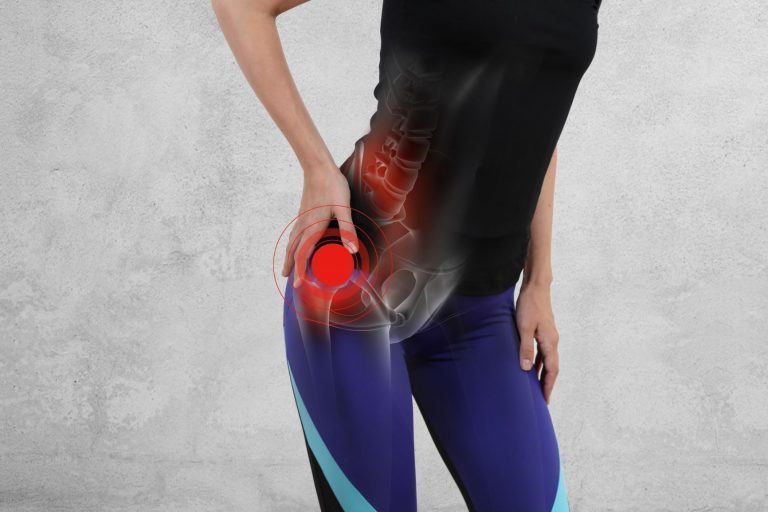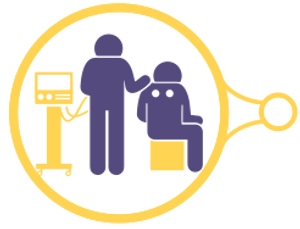
Gluteal Tendinopathy
It is common for patients to come in with hip pain and say, "I think it is arthritis" during our thorough history and examination, it quickly becomes clear that hip arthritis is not the source of their discomfort. Rather, it is a common condition called gluteal tendinopathy.
WHAT'S WRONG?
Gluteal Tendinopathy "Gluteal tendinopathy" means that one or more of the fibrous tendons that attach your buttock muscles to your hip bone have become irritated. Symptoms usually include pain on the outside of your hip, buttock, and upper thigh that started without any identifiable injury. The pain can be achy or sharp regardless of what type of pain you are experiencing it is a real pain in the butt.
You will likely notice more discomfort when walking, standing on one leg, or climbing stairs and hills. Symptoms are often quite bothersome at night. If your pain is acute, you may need to temporarily avoid aggravating activities like long-distance or fast-paced running, hill climbing, and plyometrics. Low-stress alternatives would include cycling or water-based exercises. Runners should avoid running on a bank surface, like the crown of a road or indoor track.
Be sure to reverse directions on a circular track each mile. Avoid running on wet or icy surfaces, and consider new training shoes after 300 miles. Cyclists should make certain that their seat is not positioned too high. To speed your recovery, try to land softly on the front of your heels when you walk and take shorter, quicker steps to avoid over-striding.
Avoid "hanging on one hip" and sitting or standing with your knees crossed. Restrict prolonged sitting, particularly on low-height seats. Keep your knees spread (like sitting on a horse) to ease the tension when transitioning in and out of a chair. You will likely want to avoid side-lying sleep postures, as this triggers discomfort.
You may sleep more comfortably by placing a pillow between your knees or using a memory foam or eggshell mattress topper. Avoid weighted blankets. Overweight patients will benefit from a weight reduction program. If left untreated, gluteal tendinopathy can persist and worsen. Fortunately, conservative treatment like the type provided in this office is successful in about 90% of cases.
THINGS WE CAN DO TO HELP YOU
 Therapy Modalities Like Laser or Shockwave
Therapy Modalities Like Laser or Shockwave
We may apply electrotherapy modalities that produce light electrical pulses transmitted through electrodes placed over your specific sites of concern. These comfortable modalities work to decrease your pain, limit inflammation and ease muscle spasms. Hot or cold packs are often used to enhance these modalities' effects.
Another available option is Shockwave; Shockwave is a high-intensity sound wave that can dramatically improve blood flow and speed healing in deep, dense connective tissues like your gluteal tendons. We have had great results on even chronic cases of gluteal tendinopathy with shockwave.
 Myofascial Release
Myofascial Release
Overworked muscles often become tight and develop knots or "trigger points". Chronic tightness produces inflammation and swelling that ultimately leads to the formation of "adhesions" between tissues. Your provider will apply pressure with their hands, or with specialized tools in order to release muscle tightness and soft-tissue adhesions. This will help to improve your circulation, relieve pain and restore flexibility.
 Adjustments
Adjustments
Adjustments to our spine and pelvic joints, like your sacroiliac joints, are important to keep your back and hips moving properly so that the muscles can function more normally and heal more quickly.
 Therapeutic Exercise
Therapeutic Exercise
Muscle tightness or weakness causes discomfort and alters normal joint function, leading to additional problems. Your chiropractor will target tight or weak muscles with specific therapeutic stretching and strengthening to help increase tissue flexibility, build strength, and ease EXERCISES AT HOME The following exercises have been specifically selected to assist with your recovery and help minimize future problems. Exercises should be performed slowly and within a relatively comfortable range. Maintain good posture and breathe naturally. Do not hold your breath. Unless otherwise instructed, stop any exercises that cause pain, or radiating symptoms.

Glute Bridge w/ Band

Seated Clam

Standing Weight Shift

Step-ups

Standing 3 Point Tap





